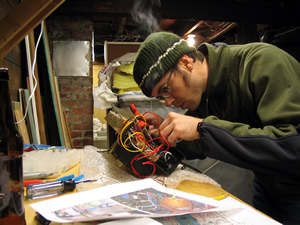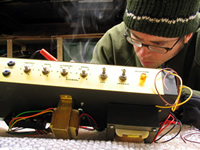. . . the moon gazed on my midnight labours, while, with unrelaxed and breathless eagerness, I pursued nature to her hiding-places. —Mary Shelley’s Frankenstein.
 I think I’ve figured out the appeal of this whole build-your-own-amp craze. It dawned on me during my soldering lesson with Al a couple weeks ago. I’d just made my first few attempts at soldering two wires together, and had discovered that when you hunch directly over the thing you’re soldering, the smoke goes up your nose. I asked Al about the safety of breathing smoke from something that’s 40% lead. Last time I checked, lead was not one of the items on the Percent Daily Values chart on the side of my Cheerios box. Al shrugged and gave me a sideways glance. “I kind of like the smell of it.”
I think I’ve figured out the appeal of this whole build-your-own-amp craze. It dawned on me during my soldering lesson with Al a couple weeks ago. I’d just made my first few attempts at soldering two wires together, and had discovered that when you hunch directly over the thing you’re soldering, the smoke goes up your nose. I asked Al about the safety of breathing smoke from something that’s 40% lead. Last time I checked, lead was not one of the items on the Percent Daily Values chart on the side of my Cheerios box. Al shrugged and gave me a sideways glance. “I kind of like the smell of it.”
You know what I smell, folks? An ADDICT.
Fact! 60/40 electronics solder isn’t really 60% tin and 40% lead. It also has what’s called a “rosin” core. The “rosin” is supposed to be a “flux,” which helps the solder to flow better. It doesn’t take Jeff Spicoli to figure out that “flux” isn’t just making the solder flow better. Your whole day’s gonna flow like lava in a lamp after a morning spent over your soldering iron.
Fact! 18watt.com, a website supposedly dedicated to discussion about replicating an obscure, long-forgotten amplifier, has over two thousand members. At this moment, at nearly 1am on a work night, fourteen guests and nine members are visiting the site. What could possibly inspire such interest in electronics, particularly in guitarists—a group not necessarily known for having populated the front row, or any row, of AP Physics classes?
Fact! Melting solder smells kinda like doobage.
I rest my case.
* * * * * * * * * * * * * * * * * * * * * * * * * * * * * * * * * * * * * * * * * * * * * * * * * * * * * * * *
 It’s been 23 days since I started my amp-building project, and in that time, in addition to replaying the Bob Marley box set about thirty times, I’ve screwed all the parts to the amp chassis and completed about half the wiring. It’s been so much fun, I’ve put off updating my blog—whenever I have the opportunity to write, I go downstairs and grab my soldering iron. There’s something meditative about soldering wires. Through a thicket of mysterious electronic components, I’m following a path, one step at a time. As long as I stay on the trail, I’ll find my way to my destination.
It’s been 23 days since I started my amp-building project, and in that time, in addition to replaying the Bob Marley box set about thirty times, I’ve screwed all the parts to the amp chassis and completed about half the wiring. It’s been so much fun, I’ve put off updating my blog—whenever I have the opportunity to write, I go downstairs and grab my soldering iron. There’s something meditative about soldering wires. Through a thicket of mysterious electronic components, I’m following a path, one step at a time. As long as I stay on the trail, I’ll find my way to my destination.
And on the way, I am learning a bit about electronics. I only have the most superficial understanding of how the components of my amp work—power transformers change voltage, capacitors store electricity, tubes make your guitar scream—but the logic in the tangle of wires is slowly becoming apparent. Instead of seeing a plate of spaghetti when I peer into the chassis, I am beginning to see meaningful electrical paths, as if I were looking at a roadmap of my hometown.

Comments 11
OK, OK, you figured out the real draw of all this amp-building nonsense – FLUX HAZE! Why else would we spend hours on end hunched in cold garages and basements laboring over ancient, bizarre, arcane circuits?
Sure, it starts with flux…but you know that leads to the stronger stuff that your parents warned you about – tolex glue, copper etchant, Caig lubricants…you most assuredly are on a path to doom!
Anyway: got it working yet? 🙂
Ha ha ha!
I’ve almost finished soldering the tube sockets–just have to do the heater wires. Then the only thing that’s left is the pots, and I’ll have to buy some tubes and a speaker.
Once they’re all it place, I guess I’ll plug the puppy in, and get Al to fire it up while I hide behind the water heater…
Just a note for your next build…it is usually easier to hook up the heater wires first. Twist them together, run them against the chassis, and cross other wires at 90 degrees. Not sure how much your kit instructions details, but the heaters also should be in phase — that is, Pin 5 on every tube should be wired together leaving pin 4 on the 84s and pin 9 on the X7s to be wired together.
…and of course, Al knows the startup procedure…
http://www.paulrubyamps.com/info.html#FirstPowerUp
I’ve had a growing suspicion since I started soldering the tube sockets that it would have been easier to do the heater wires first. Something to remember for next time…
As for the heaters being in phase, I’m following Ceriatone’s layout and photos, just connecting the dots.
I understand there’s a startup procedure for new amps, but the link you sent me looks like the clearest, most detailed description I’ve seen. Thanks a bunch! I think Al just started his up and got lucky–I’m going to be more conservative and go throught the whole procedure.
Thanks a ton for all your guidence,
Rob
…and there WILL be a next time… 🙂
From all accounts, Nic’s instructions are pretty good, so you shouldn’t have many problems.
The “Ruby Startup Procedure” is more or less tribal-knowledge standard.
As always, 18watt.com is your friend.
This is so cool. Can’t wait to hear about how it sounds. Should be awesome.
I might be catching the amp building bug too. There’s a cool one outlined in The Guitar Amp Book by Dave Hunter….get’s me thinking.
HEY!!
Did you ever finish this? If not, put down the mouse right now, and go DO IT!
Hey MC,
Damn, I’ve got people cracking the whip on all sides. Even my girlfriend wants me to finish.
I’ve had some sickness in my family recently that’s taken much of my amp-building time. But today I’m the one who’s sick—just a cold, thankfully—and I think it might be time to finish soldering those pots.
I did order a speaker and tubes, so I’m almost ready to test things out. Definately in the next few weeks, I promise, I promise!
Hey everyone, Rob DID finish it. And I took pictures when he switched it on. The thing smoked, caught fire and then burned the house down. It’s all on film. How come you don’t post it, Rob?
No….. That’s not what happened.
There was a loud piercing squeal. Like a smoke alarm going off. So we turned it off and looked at it. Hmmm. All the knobs were turned down. So we put them half-way up. Turned it on, squeal gone! Could it really be that simple? Seems it only squealed if the tone pots were all the way down. So we centered them. Pure silence. Blissfully hum free.
Rob got the Les Paul.
He turned the volume up full.
And the most gorgeous sustained distortion poured out. Rich, detailed, articulate, phat. Like that first taste of beer on Friday. Like butter on pancakes. Like sex with everyone you’ve ever dreamed of. At once.
And when wild man Rob held the guitar to the speaker (the way you know he likes to) the feedback careened out just like it does on TV!
We were in Rob’s basement, and just then his girlfriend arrived and said she heard it from the street. “You guys having a party?”
Who, us?
It was at this point that I noticed the 18 Watt has no gain knob. Just volume.
“Right,” Rob said. “You want distortion, you gotta play loud. Like our forefathers did.”
So we kinda did burn the house down after all.
Now Rob seems to be in the midst of figuring out the cabinet issue. I’ll let him post about that.
Rob?
Uh, Rob? Can you stop singing and finish the amp?
OK, OK, OK!
http://www.heartwoodguitar.com/WordPressBlog/?p=52
Sheesh!